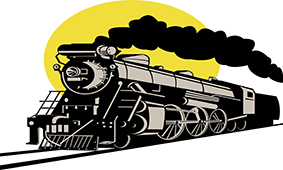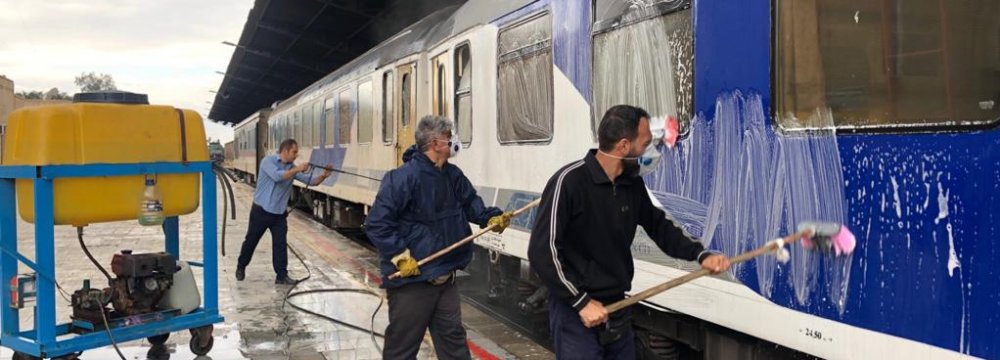
Iranian Rail Firms to Suffer Losses Worth $37 Million by June 20

Noting that the number of rail passengers fell by 94% during the Iranian New Year holidays (March 20-April 3) compared with last year’s similar period, Mehrdad Taqizadeh added that a total of 300,000 tickets were cancelled and 910 billion rials ($5.6 million) were paid back to people following the disease outbreak, Fars News Agency reported.
Rail companies have sought to keep their passengers amid the coronavirus disease, COVID-19, by regularly disinfecting their trains.
Taqizadeh noted that his guild will seek a 2,000-billion-rial ($12.5 million) bailout and loans with an interest rate of 4% for rail companies in a letter to the government.
Latest data show the Iranian rail network transported 27.96 million passengers in the fiscal 2018-19.
“Between 2013 and 2017, rail ridership averaged at 24 million from 28 million-odd of the early 2010s. It was only after airfare hikes in that year, that a number of passengers shifted to rail transportation services,” Mohsen Sadeqi, a civil engineer in charge of the Economic Evaluation Office at the Ministry of Roads and Urban Development, said.
A total of 300,000 tickets were cancelled and 910 billion rials ($5.6 million) were paid back to people, following the coronavirus outbreak
"The share of passenger rail in transportation does not seem to experience a dramatic growth in years to come unless tracks get upgraded with train speeds of up to 180 kilometers per hour," he told the Persian economic daily, Donya-e-Eqtesad.
Asked about the failure of Iranian governments to allocate resources for the development of high-speed rail networks, Sadeqi said he believes such investments depend on economic growth.
“Low gross domestic product growth is a disabler that hampers the import of technology. After all, countries that have built high-speed rail networks mostly enjoy high levels of GDP,” he said.
According to Ministry of Roads and Urban Development's fiscal 2018-19 estimations, more than $18 billion are needed to build one high-speed rail line between the cities of Tehran and Mashhad, the most popular train route in Iran with 2.3 million passengers per year. This comes as a whole slew of development projects have been left incomplete in the country.
“The question is how we go about pricing the tickets of an $18-billion rail project, even if the needed capital expenditure becomes available. Last year’s studies showed that a return ticket on this route—Tehran to Mashhad—must be around 20 million rials ($156), almost six times more expensive than the tickets of conventional train operating then. The country won’t recoup such an initial investment even if as many as 20 million trips are made on this route per year,” Sadeqi said.
Iran’s rail network carries around 28 million passengers annually. The number of passengers on domestic flights stands at 17-18 million.
Taking into account the number of passengers on international flights, the annual air passengers’ number would exceed that of rail passenger traffic.
According to Sadeqi, nearly 200 million road trips are made by buses and taxis every year and estimates reveal that people make more than 1.2 billion trips on their personal cars annually. The total number of domestic journeys hovers around 1.5 billion per annum, of which 28 million are made by train.
Sadeqi noted that Iran’s rail fleet consists of 2,089 passenger cars, 25,398 freight wagons and 1,000 locomotives.
The number of passengers using suburban train services has increased from three million in the fiscal 2014-15 to seven million last year (March 2018-19).
As of the fiscal 2011-12, rail freight transport has witnessed a 50% growth, improving from 33 million tons then to around 50 million tons of freight per annum in recent years.



Trump weighs using $2 billion in CHIPS Act funding for critical minerals

Codelco cuts 2025 copper forecast after El Teniente mine collapse

Electra converts debt, launches $30M raise to jumpstart stalled cobalt refinery

Barrick’s Reko Diq in line for $410M ADB backing

Abcourt readies Sleeping Giant mill to pour first gold since 2014

Nevada army depot to serve as base for first US strategic minerals stockpile

SQM boosts lithium supply plans as prices flick higher

Viridis unveils 200Mt initial reserve for Brazil rare earth project

Tailings could meet much of US critical mineral demand – study

Kyrgyzstan kicks off underground gold mining at Kumtor

Kyrgyzstan kicks off underground gold mining at Kumtor

KoBold Metals granted lithium exploration rights in Congo

Freeport Indonesia to wrap up Gresik plant repairs by early September

Energy Fuels soars on Vulcan Elements partnership

Northern Dynasty sticks to proposal in battle to lift Pebble mine veto

Giustra-backed mining firm teams up with informal miners in Colombia

Critical Metals signs agreement to supply rare earth to US government-funded facility

China extends rare earth controls to imported material

Galan Lithium proceeds with $13M financing for Argentina project

Kyrgyzstan kicks off underground gold mining at Kumtor

Freeport Indonesia to wrap up Gresik plant repairs by early September

Energy Fuels soars on Vulcan Elements partnership

Northern Dynasty sticks to proposal in battle to lift Pebble mine veto

Giustra-backed mining firm teams up with informal miners in Colombia

Critical Metals signs agreement to supply rare earth to US government-funded facility

China extends rare earth controls to imported material

Galan Lithium proceeds with $13M financing for Argentina project

Silver price touches $39 as market weighs rate cut outlook

















